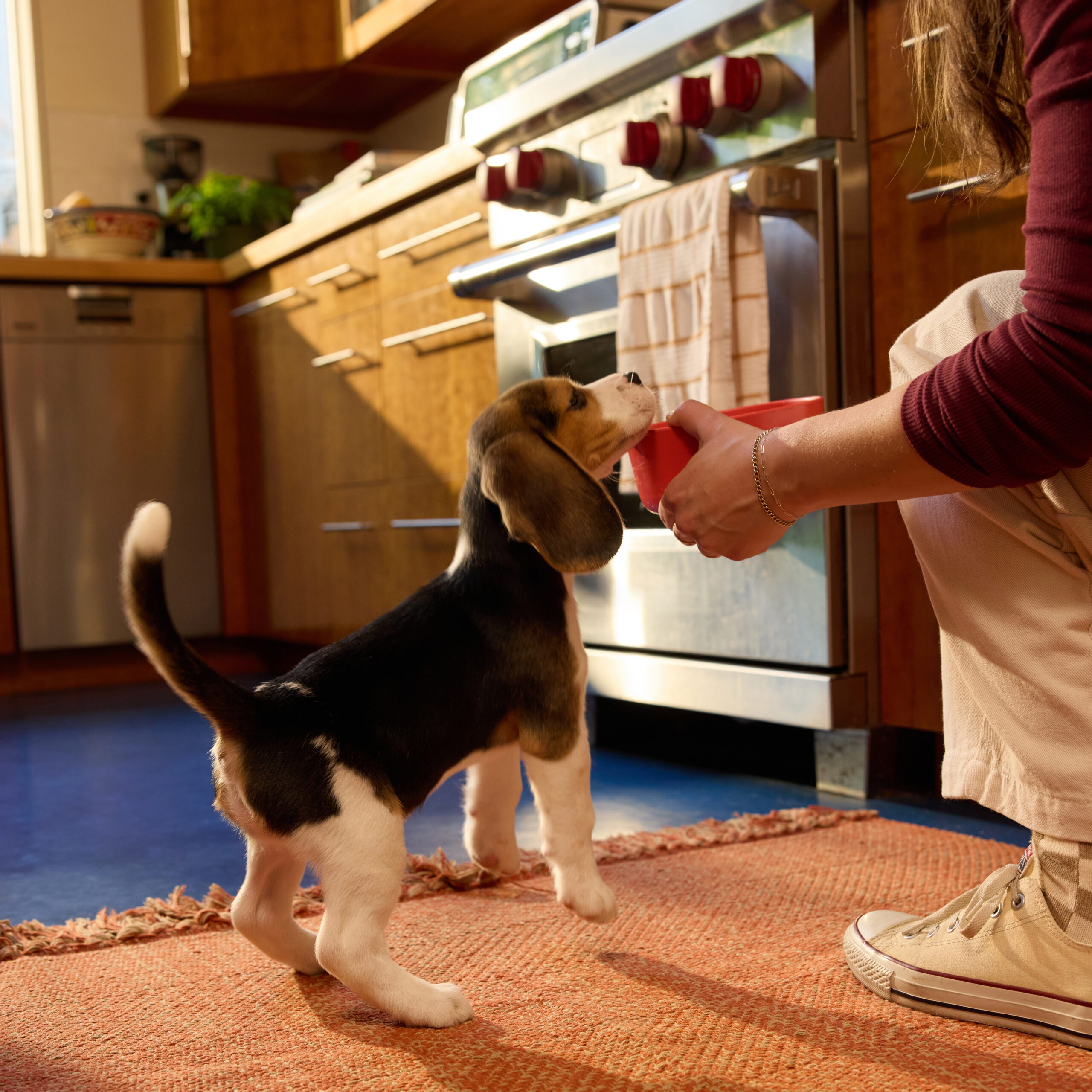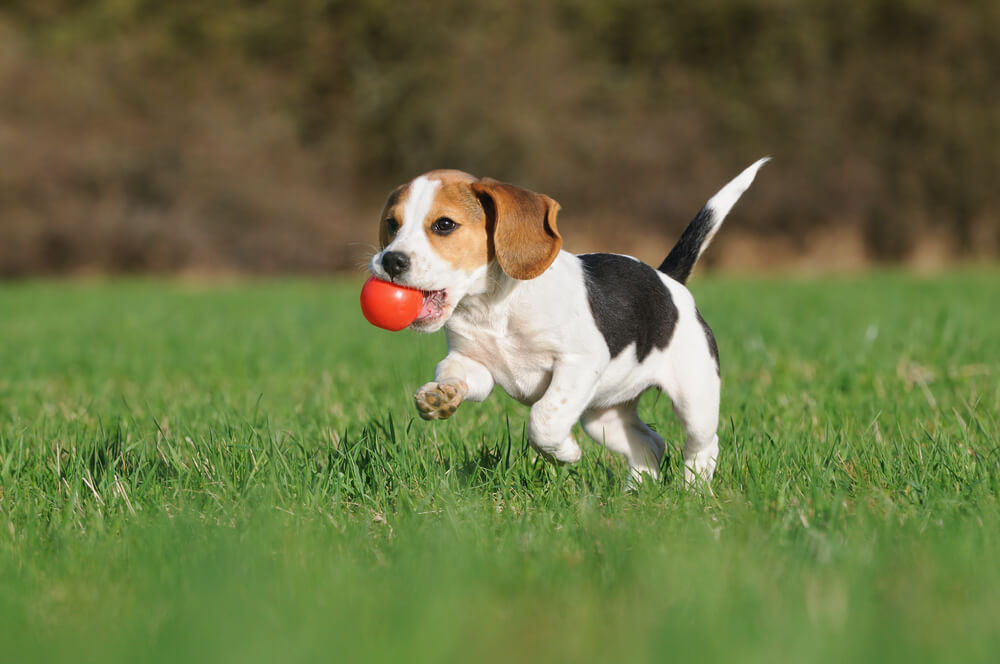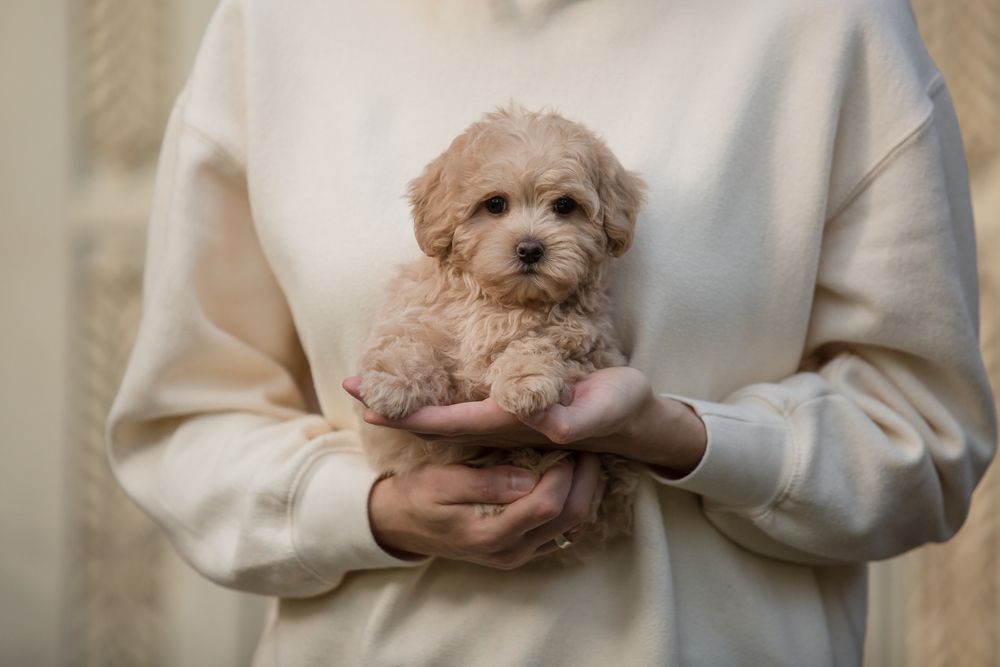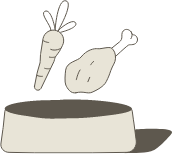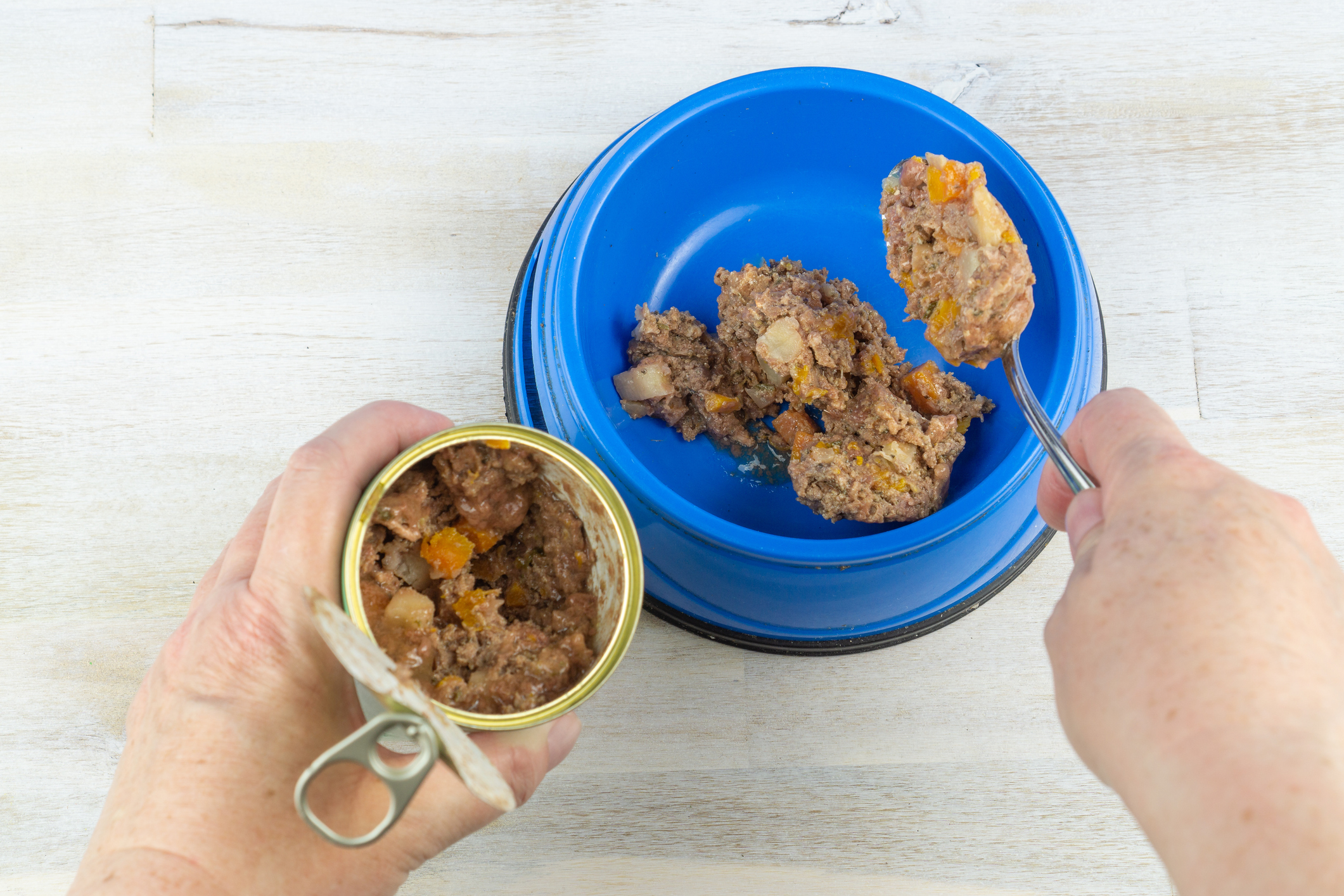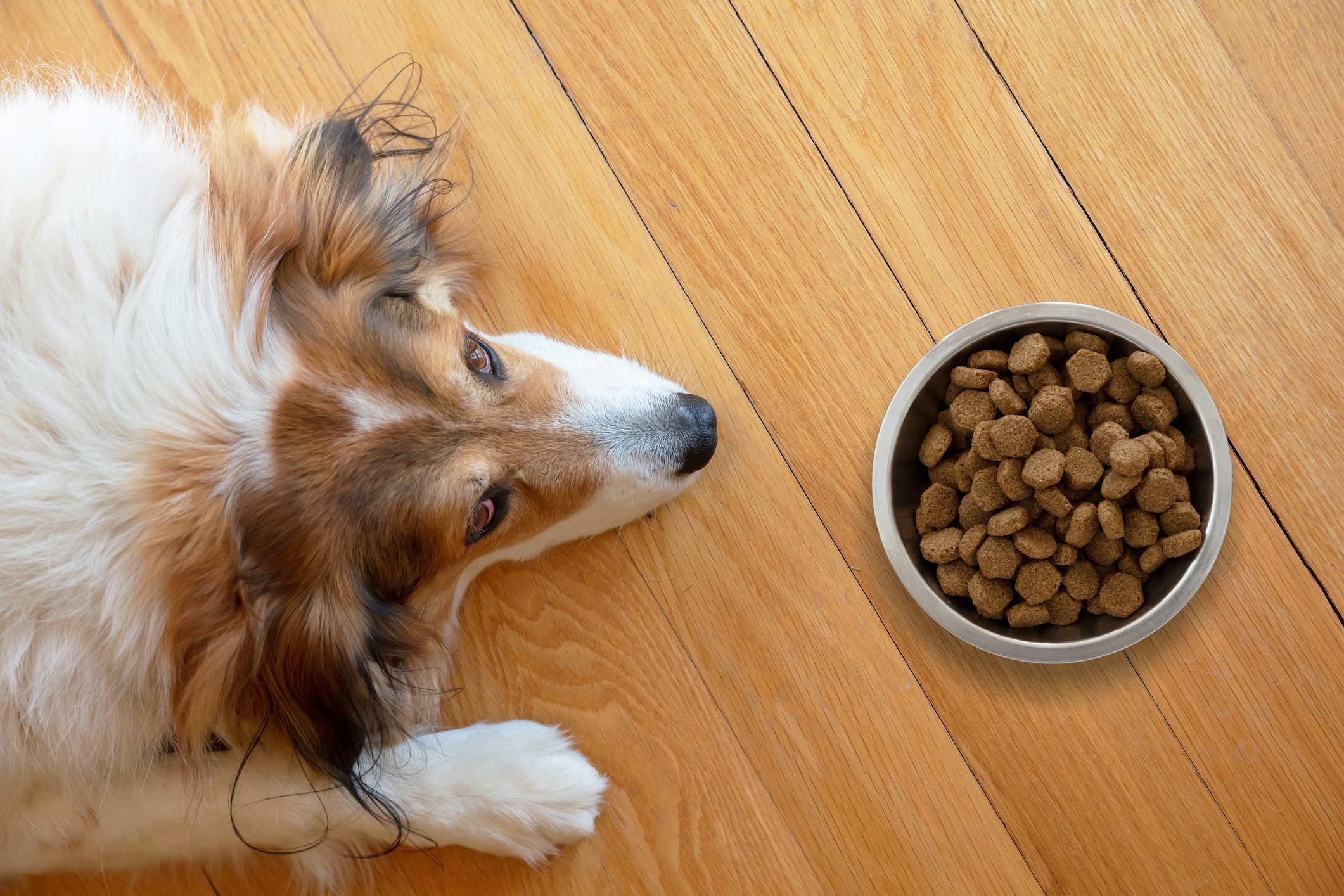Hey Ollie blog readers! We’re offering you an exclusive 60% OFF your starter box! Try now!
Puppies have rapidly changing nutritional needs as they develop from tiny bundles of energy into healthy, happy adult dogs. Growing puppies need more calories, fat, protein and essential nutrients than adult dogs [1]. Too much food can lead to rapid weight gain and joint problems, while too little can cause developmental issues or hypoglycemia in smaller breeds.
In this guide, you’ll discover:
- Feeding charts by age and weight to determine exact portion sizes
- Life stage feeding schedules for optimal growth
- Best food for puppies including fresh vs. kibble comparisons
- Expert tips for healthy feeding habits
Whether you’re preparing your first puppy meal or adjusting portions as they grow, this guide provides everything you need to feed with confidence.
Puppy Feeding Chart by Age and Weight
Every puppy grows at their own pace, but these general guidelines help ensure proper nutrition throughout their development. Base portions on your puppy’s expected adult weight for the most accurate feeding amounts.
| Expected Adult Weight | 1.5–3 months | 4–5 months | 6–8 months | 9–11 months | 1–2 years |
| 3–12 lb | ½ – 1 cup | ⅔ – 1⅓ cups | ½ – 1½ cups | Feed as adult | Feed as adult |
| 13–20 lb | ½ – 1¼ cups | 1⅛ – 2 cups | ¾ – 1⅓ cups | ½ – 1½ cups | Feed as adult |
| 21–50 lb | ½ – 1½ cups | 1½ – 2¾ cups | 1⅛ – 2⅔ cups | 2 – 3 cups | 2 – 4¼ cups |
| 51–75 lb | ⅝ – 2⅔ cups | 1½ – 4 cups | 1½ – 3¾ cups | 2½ – 4¾ cups | 2½ – 6¼ cups |
| 76–100 lb | 1 – 2⅔ cups | 2⅞ – 3¾ cups | 2⅞ – 6⅓ cups | 3⅞ – 7 cups | 5½ – 11 cups |
| 101+ lb | 2⅔ cups + ⅓ cup for every 10 lb over 100 lb | 3¾ cups + ⅓ cup/10 lb | 6⅓ cups + ⅓ cup/10 lb | 7 cups + ⅓ cup/10 lb | 11 cups + ⅓ cup/10 lb |
Important: These amounts assume high-quality puppy food with balanced nutrition. Individual needs vary based on breed, metabolism, and activity level.
Puppy Development Stages and Feeding Guidelines
Stage 1: 8-12 Weeks (Early Puppyhood)
At this critical stage, puppies need frequent, small meals to support rapid growth and development. When shopping for puppy food, our veterinarians recommended focusing on foods that meet the standards set by the Association of American Feed Control Officials, or AAFCO. Dog foods carrying the AAFCO stamp are guaranteed to meet certain nutritional and labeling requirements [2].
Key Requirements:
- Meal frequency: 3-4 small meals daily
- Special nutrition: Large breed puppies need specifically formulated food to prevent joint issues
- Feeding schedule: Regular timing supports housetraining
Sample Daily Schedule:
| Time | Activity |
| 6:00 AM | Wake up and potty break |
| 6:30 AM | Breakfast #1 |
| 9:30 AM | Breakfast #2 (can be used for training) |
| 12:00 PM | Lunch |
| 5:00 PM | Dinner |
| 6:00 PM | Light snack during family dinner |
Stage 2: 3-6 Months (Rapid Growth)
Around 3 months, you can reduce meal frequency while maintaining proper nutrition. This simplifies schedules and supports housetraining progress.
Key Changes:
- Reduce to 3 meals daily aligned with family mealtimes
- Monitor body condition as growth rates vary
- Adjust portions frequently based on development
Stage 3: 6-12 Months (Adolescence)
Growth begins to slow for most breeds, allowing transition to twice-daily feeding. Large and giant breed dogs grow incredibly rapidly during their first year of life. Again using the example of Great Danes, who are generally 1-2 pounds at birth, in their first year they can reach a weight of between 90 and 140 pounds [3].
Important Considerations:
- Two meals daily prevent overeating
- Large breeds may need puppy food longer
- Begin researching adult foods for eventual transition
Stage 4: 12+ Months (Maturity)
Switching from a puppy-specific diet to adult dog food depends on your dog’s breed and size. “The appropriate time to change to adult food is generally anywhere from 6 months to 14 months,” says Ostermeier [4]. Large and giant breeds may continue needing puppy food until 18-24 months.
Best Food for Puppies: Fresh vs. Traditional Options
Fresh Dog Food Benefits for Puppies
Studies have shown that dogs fed fresh diets can live up to 2.5 years longer than those on commercial diets [5]. Fresh food has proven to be highly digestible. Dogs absorb nutrients better from fresh food than kibble diets, showing higher digestibility rates for dry matter, organic matter, energy, and fats [5].
Key Advantages:
- Higher digestibility: Unlike kibble, which undergoes high-heat processing that can degrade nutrients, fresh dog food is minimally processed and retains more vitamins, minerals, and enzymes. Studies have shown that fresh food can be higher in essential nutrients like B vitamins and omega-3 fatty acids [6]
- Better palatability: Ideal for picky eaters
- Fewer processed ingredients: Reduced risk of food sensitivities
What Makes Quality Puppy Food
When shopping for puppy food, our veterinarians recommended focusing on foods that meet the standards set by the Association of American Feed Control Officials, or AAFCO. Dog foods carrying the AAFCO stamp are guaranteed to meet certain nutritional and labeling requirements [2].
Essential Features:
- AAFCO compliance for complete and balanced nutrition
- Life stage appropriate formulation
- High-quality protein sources as first ingredients
- Appropriate calcium levels for large breeds
Top Puppy Food Recommendations
We especially like the fact Ollie offers customized meal plans tailored to meet the individual requirements of your puppy – after all every dog is different! [1] Ollie’s fresh food provides recipes formulated with veterinary nutritionists using human-grade ingredients, making it an excellent choice for growing puppies.
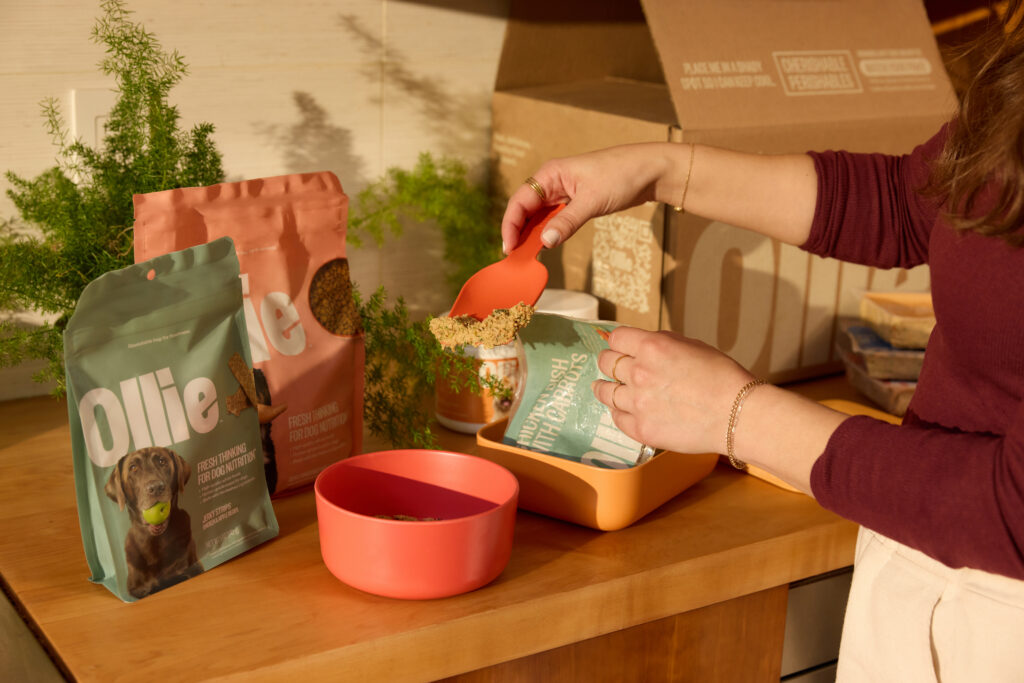
Calculating Individual Meal Portions
To determine how much to feed at each meal, consider these factors:
Individual Variables:
- Age and current weight
- Breed size and expected adult weight
- Activity level
- Health status
- Food type and caloric content
Calculation Method:
- Use the feeding chart to determine daily portion
- Adjust for activity level (increase by 10-25% for very active puppies)
- Divide total daily amount by number of meals
- Monitor body condition and adjust as needed
Example: An 18-pound, 4-month-old puppy needing 2 cups daily would receive approximately ⅔ cup per meal when fed three times daily.
Essential Feeding Tips for Healthy Puppies
Establish Consistent Routines
Creating a mealtime routine is one of the most important things to do when you get a new puppy: “Choose a schedule that is convenient for you and your family so that you can stick to the routine — if you create a routine, the puppies will follow,” says Dr. Nell Ostermeier [4].
Manage Food Transitions Carefully
When changing foods, use a gradual 7-10 day transition to prevent digestive upset:
- Days 1-2: 75% old food, 25% new food
- Days 3-4: 50% old food, 50% new food
- Days 5-6: 25% old food, 75% new food
- Days 7+: 100% new food
Count Training Treats as Calories
High-value treats accelerate training but add significant calories. Reduce meal portions on heavy training days or use your puppy’s regular food as training rewards.
Use Feeding Aids for Better Digestion
Puzzle feeders and slow-feed bowls prevent rapid eating, which can cause:
- Indigestion and vomiting
- Bloat (potentially life-threatening)
- Reduced nutrient absorption
Monitor Body Condition Regularly
Learn to assess your puppy’s body condition by:
- Feeling for ribs: Should be easily felt but not visible
- Observing waist tuck: Visible when viewed from the side
- Weekly weigh-ins: Track growth patterns

Why Ollie is the Best Fresh Food for New Puppies
At Ollie, we understand that growing puppies have unique nutritional needs. Our recipes are formulated with veterinary nutritionists to provide:
Complete Nutrition:
- All essential nutrients for healthy growth
- Omega-3 fatty acids for brain development
- High-quality proteins for muscle development
- Antioxidant-rich ingredients for immune support
Convenience and Customization:
- Personalized meal plans based on your puppy’s specific needs
- Pre-portioned meals eliminate guesswork
- Fresh delivery to your door
- Automatic adjustments as your puppy grows
Quality Ingredients:
- Human-grade proteins including chicken, turkey, beef, pork, and lamb
- No fillers, artificial preservatives, or by-products
- Gently cooked to preserve nutrients and flavor
- Complete and balanced for all life stages
Our recipes support healthy eating habits from the start, eliminating finicky behavior while providing optimal nutrition. When you choose Ollie, you’re investing in your puppy’s long-term health and happiness.
Frequently Asked Questions
Q: How often should I feed my puppy?
A: Feed puppies 8-12 weeks old 3-4 times daily, 3-6 months old 3 times daily, and 6+ months old twice daily.
Q: When should I switch from puppy to adult food?
A: The appropriate time to change to adult food is generally anywhere from 6 months to 14 months. Large to giant breed dogs should usually take longer to transition so they don’t grow as quickly. They typically need to switch after 1 year and even up to 2 years for giant breeds [4].
Q: Is fresh food better than kibble for puppies?
A: Studies have shown that dogs fed fresh diets can live up to 2.5 years longer than those on commercial diets [5]. Fresh food offers better digestibility, palatability, and nutrient retention compared to traditional kibble.
Q: How do I know if I’m feeding the right amount?
A: Monitor your puppy’s body condition regularly. You should be able to feel but not see their ribs, and they should have a visible waist tuck when viewed from the side.
Q: Can I use my puppy’s food for training treats?
A: Yes! Using regular food as training rewards helps prevent overfeeding while maintaining nutritional balance. Reserve portion from meals for training sessions.
Ready to give your puppy the best start? Discover Ollie’s puppy meal plans and provide your growing pup with the nutrition they deserve for a healthy, happy future.
Citations
[1] https://www.dogfoodadvisor.com/best-dog-foods/best-puppy-foods/
[2] https://www.petmd.com/dog/vet-verified/best-puppy-food
[3] https://www.consumersadvocate.org/dog-food
[4] https://www.nbcnews.com/select/shopping/best-puppy-food-rcna151536
[5] https://www.deliveryrank.com/blog/kibble-vs-fresh-food
[6] https://www.thehonestkitchen.com/blogs/pet-food-ingredients/fresh-dog-food-vs-dry
Tagged As:

The nutrition your dog needs,
the food they want.

Enjoying our articles? Subscribe our Newsletters and get new articles directly to your inbox
You might also like
18 August 2025
3 MINS READ
5 Risks of Canned Dog Food Pet Parents Miss
While canned dog food might seem like a convenient choice for your pup, it carries several hidden risks that could impact their health. Understanding these concerns will help you make better decis…
by Ollie Pets
18 August 2025
6 MINS READ
What Pet Parents Need to Know About Extruded Kibble
Not all dog food is created equal. When choosing a diet, it’s important to consider how the way your dog’s food is made impacts their overall health and nutrition. Understanding the manufacturin…
by Ollie Pets
18 August 2025
9 MINS READ
Nourish Skin from Within: Fresh Dog Diet Benefits
If your dog is constantly scratching, licking their paws, or has a dull, flaky coat, it’s not just frustrating—it could be a sign that something’s off in their diet. Skin and coat issues are som…
by Ollie Pets
